Choral music, often referred to as the “singing together” of voices in harmony, is a genre that has transcended centuries, cultures, and boundaries. It is a powerful and emotive form of musical expression that brings people together through the shared experience of singing in unison. In this blog post, we will delve into the world of choral music, exploring its rich history, its significance in various cultures, and the impact it has on both performers and audiences.
A Timeless Tradition
Choral music has a long and illustrious history that dates back to ancient civilizations. It has been a fundamental part of religious rituals, royal ceremonies, and cultural events for centuries. From Gregorian chants in medieval Europe to the intricate harmonies of modern choral compositions, this genre has evolved and adapted to reflect the changing times while preserving its core essence – the beauty of voices in harmony.
Cultural Diversity in Harmony
One of the most enchanting aspects of choral music is its ability to unite people from diverse backgrounds and cultures. Whether it’s the hauntingly beautiful polyphony of Eastern Orthodox chants, the uplifting gospel choirs of the United States, or the mesmerizing Maori waiata of New Zealand, choral music allows cultures to express their unique identities through song while also finding common ground in the universal language of music.
The Power of Unity
Choral singing is not just about producing harmonious sounds; it’s about fostering a sense of unity and community. When voices blend together seamlessly, it creates a powerful and emotional experience that transcends individual voices. Choir members often speak of the camaraderie and sense of belonging that come from being part of a collective effort to create something beautiful.
A Healing Force
Choral music has the unique ability to touch the soul and heal the heart. It has been used in therapeutic settings to help individuals cope with grief, reduce stress, and find solace. Singing in a choir can provide a sense of purpose and emotional support, making it a powerful tool for well-being.
Evolving with the Times
While choral music has deep roots in tradition, it also continues to evolve and adapt to contemporary styles and themes. Modern choral composers draw inspiration from a wide range of sources, infusing new life into the genre with innovative compositions that explore complex emotions and societal issues.
Experience the Magic
Whether you’re a seasoned choral enthusiast or someone new to the world of harmonious voices, there’s always something magical waiting to be discovered in choral music. Attend a local choir performance, explore diverse choral traditions from around the world, or even consider joining a choir yourself to experience the joy of singing in harmony with others.
In conclusion, choral music is a timeless and profound art form that resonates with people from all walks of life. It has the power to inspire, heal, and unite, and its beauty lies in the voices that come together to create something greater than the sum of its parts. So, let your voice be heard, and let choral music fill your heart with its awe-inspiring beauty.


Add Comment